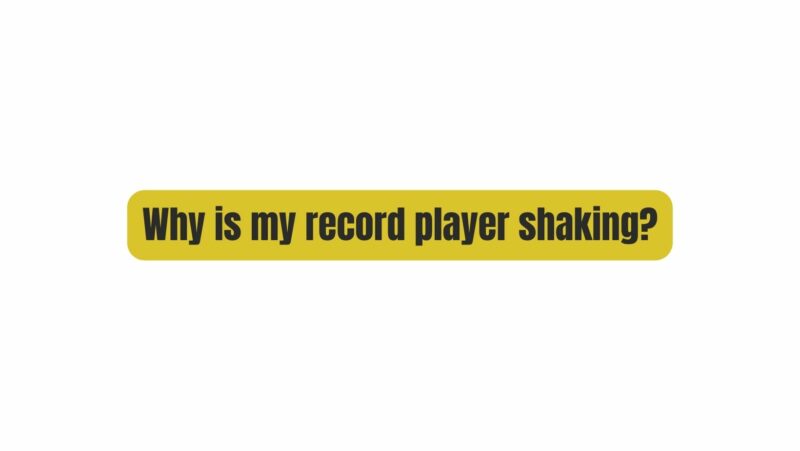The mesmerizing experience of listening to vinyl records has seen a resurgence in recent years, drawing enthusiasts and audiophiles alike to the warm, analog sound of a record player. However, like any other mechanical device, record players can encounter issues that affect their performance. One common problem that can mar your listening experience is when your record player starts shaking or vibrating unexpectedly. In this comprehensive article, we will delve into the reasons behind this issue and provide you with troubleshooting steps and solutions to get your record player back to delivering the smooth, high-quality sound you love.
I. Understanding the Basics of Record Players
Before we dive into the causes of record player shaking, it’s essential to have a basic understanding of how these devices work.
A. The Turntable and Its Components
- Platter: The circular surface where the vinyl record sits.
- Tonearm: The arm that holds the stylus and cartridge, responsible for tracking the grooves on the record.
- Stylus/Needle: The part of the tonearm that makes contact with the record’s grooves and reads the audio information.
- Cartridge: The component that houses the stylus and converts mechanical vibrations into electrical signals.
- Motor: The engine of the record player responsible for rotating the platter at a consistent speed.
B. The Importance of Balance and Stability
To produce high-quality audio, a record player needs to maintain precise balance and stability. Any disruptions in this balance can lead to shaking or vibrating issues.
II. Common Causes of Record Player Shaking
Now that we understand the essential components of a record player, let’s explore the common causes of shaking or vibrating issues.
A. Uneven Surface
- Solution: Ensure your record player is placed on a level and stable surface. The slightest tilt can lead to vibrations.
B. Faulty Motor or Drive Belt
- Solution: If your turntable’s motor or drive belt is worn out or damaged, it can cause irregular rotation and shaking. Consult the manufacturer or a technician for replacement and repairs.
C. Tonearm Imbalance
- Solution: Check the balance of your tonearm. It should be parallel to the platter. Adjust the counterweight and anti-skate settings according to your turntable’s user manual to achieve proper balance.
D. Stylus or Cartridge Issues
- Solution: A damaged or worn-out stylus can cause skipping, shaking, or distorted sound. Replace the stylus or cartridge as needed. Ensure they are properly aligned and calibrated.
E. Record Warping
- Solution: Warped records can lead to vibrations. Inspect your vinyl records for warping and consider using a record weight or clamp to minimize vibrations caused by warped records.
F. External Vibrations
- Solution: External sources of vibrations, such as footsteps, loudspeakers, or nearby appliances, can affect your record player’s performance. Isolate your turntable from these vibrations or move it to a quieter location.
G. Suboptimal Platter Mat
- Solution: Some platter mats can transmit vibrations instead of dampening them. Consider using a high-quality mat designed to reduce vibrations.
H. Tracking Force and Anti-Skate Settings
- Solution: Incorrect tracking force and anti-skate settings can lead to shaking and skipping. Consult your turntable’s manual to set these parameters correctly.
III. Advanced Troubleshooting
If you’ve addressed the common causes and your record player is still shaking, it’s time to consider more advanced troubleshooting steps.
A. Bearing Lubrication
- Solution: Over time, the bearings in your turntable’s motor and tonearm can accumulate dust and debris, affecting their performance. Consult a technician for professional cleaning and lubrication.
B. Isolation Platform
- Solution: An isolation platform or shelf designed to absorb vibrations can help minimize external interference.
C. Upgrading Components
- Solution: Consider upgrading specific components of your turntable, such as the tonearm, plinth, or motor, to improve stability and reduce vibrations.
IV. Preventive Maintenance
To keep your record player in optimal condition and prevent shaking issues from arising, follow these preventive maintenance tips:
A. Keep Your Turntable Clean
- Regularly clean your turntable, tonearm, and stylus to remove dust and debris that can affect performance.
B. Store Vinyl Records Properly
- Store your vinyl records upright in a cool, dry place to prevent warping.
C. Maintain Proper Tracking Force
- Check and adjust the tracking force periodically to ensure accurate playback.
D. Avoid Excessive Vibration
- Place your turntable away from sources of vibration and loudspeakers.
Conclusion
The joy of listening to vinyl records is a unique and cherished experience. To ensure your record player delivers the best possible sound quality, it’s crucial to address any shaking or vibrating issues promptly. By understanding the fundamental components of your turntable, identifying common causes of shaking, and following the troubleshooting steps outlined in this article, you can enjoy your vinyl collection to the fullest. Remember, a well-maintained and stable record player will provide you with years of musical enjoyment.


